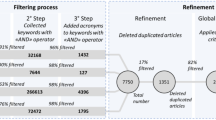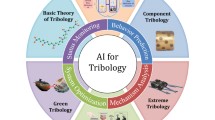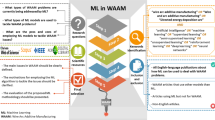Abstract
An important aspect of design for the life cycle is assessing the disassemblability of products. This paper presents a novel approach to automatic generation of disassembly sequence from hierarchical attributed liaison graph (HALG) representation of an assembly through recursively decomposing the assembly into subassemblies. In order to increase the planning efficiency, the HALG is built according to the knowledge in engineering, design and demanufacturing domains. In this method, the boundary representation (B-Rep) models are simplified by removing the hidden surfaces to reduce the computational complexity of disassembly planning. For each layer of HALG, the subassembly selection indices defined in terms of mobility, stability, and parallelism are proposed to evaluate the extracted tentative subassemblies and select the preferred subassemblies. To verify the validity and efficiency of the approach, a variety of assemblies including some complicated products are tested, and the corresponding results are presented.
Similar content being viewed by others
References
Siddique Z, Rosen DW (1997) A virtual prototyping approach to product disassembly reasoning. Comput Aided Des 29:847–860
Kuo TC, Huang S, Zhang H (2001) Design for manufacture and design for ‘X’: concepts, applications and perspectives. Comput Ind Eng 41:241–260
Eng T–H, Ling Z–K, Olson W, et al (1997) Feature-based assembly modeling and sequence generation. Comput Ind Eng 36:18–33
Yuan B, Zhou Y, Hu SM, Sun JG (2000) The assembly model of hierarchical components. J Comput Aided Des Comput Graph 12:450–454 (in Chinese)
Eastman CM (1981) The design of assembly. SAE Technical Paper Series 0148-7191/81/0223–0197
Homem De Mello LS, Sanderson AC (1991) A correct and complete algorithm for the generation of mechanical assembly sequences. IEEE T Robotic Autom 7:228–240
Ko H, Lee K (1987) Automatic assembling procedure generation from mating conditions. Comput Aided Des 19:3–10
DeFazio TL, Whitney DE (1987) Simplified generation of all mechanical assembly sequences. IEEE T Robotic Autom 3:640–658
Wilson RH (1995) Minimizing user queries in interactive assembly planning. IEEE T Robotic Autom 11:308–312
Homem de Mello LS, Sanderson AC (1991) A correct and complete algorithm for the generation mechanical assembly sequences. IEEE T Robotic Autom 7:228–240
Baldwin DF, Abell TE, Lui M–CM, De Fazio TL, Whitney DE (1991) An integrated computer aid for generating and evaluating assembly planning. IEEE T Robotic Autom 7:78–94
Chakrabarty S, Wolter J (1997) A structure-oriented approach to assembly sequence planning. IEEE T Robotic Autom 13:14–29
Swaminathan A, Barber KS (1996) An experience-based assembly sequence planner for mechanical assemblies. IEEE T Robotic Autom 12:252–266
Yin ZP, Ding H, Li HX, Xiong YL (2003) A connector-based hierarchical approach to assembly sequence planning for mechanical assemblies. Comput Aided Des 35:38–56
Zha XF, Du H (2002) A PDES/STEP-based model and system for concurrent integrated design and assembly planning. Comput Aided Des 34:1087–1110
Srinivasan H, Figueroa R, Gadh R (1999) Selective disassembly for virtual prototyping as applied to de-manufacturing. Robot Com-Int Manuf 15:231–245
Hu D, Hu Y, Li C (2002) Mechanical product disassembly sequence and path planning based on knowledge and geometric reasoning. Int J Adv Manuf Technol 19:688–696
Desai A, Mital A (2003) Evaluation of disassemblability to enable design for disassembly in mass production. Int J Ind Ergon 32:265–281
Torres F, Puente ST, Aracil R (2003) Disassembly planning based on precedence relations among assemblies. Int J Adv Manuf Technol 21:317–327
Kuo Tsai C (2000) Disassembly sequence and cost analysis for electromechanical products. Robot Com-Int Manuf 16:43–54
Moore KE, Gungor A, Gupta SM (1998) A petri net approach to disassembly process planning. Comput Ind Eng 35:165–168
Moore KE, Gungor A, Gupta SM (2001) Petri net approach to disassembly process planning for products with complex AND/OR precedence relationships. Eur J Oper Res 135:428–449
Gungor A, Gupta SM(1998) Disassembly sequence planning for products with defective parts in product recovery. Comput Ind Eng 35:161–164
Ong NS, Wong YC (1999) Automatic subassembly detection from a product. Int J Adv Manuf Technol 15: 425–431
Lee S (1994) Subassembly identification and evaluation for assembly planning. IEEE T Syst Man Cyb 24:493–503
Murayama T, Kagawa K, Oba F (1999) Computer-aided redesign for improving recyclability. Proceedings of EcoDesign’99: 1st international symposium on environmentally conscious design and inverse manufacturing, Tokyo, Japan, pp 746–751
Hoppe H (1996) Progressive meshes. Proceedings of SIGGRAPH’96, New York, ACM Press, pp 99–108
Hussain M, Okada Y, Niijima K (2001) Efficient simplification of polygonal surface models. Proceedings of the 5th international conference on information visualisation, London, England, pp 464–469
Zhu H, Menq CH (2002) B-rep model simplification by automatic fillet/round suppressing for efficient automatic feature recognition. Comput Aided Des 34:109–123
Koo S, Lee K (2002) Wrap-around operation to make multi-resolution model of part and assembly. Comput Graph 26:687–700
Tian LZ, Fu YL, Ma YL, et al (2001) Finding disassembly direction in assembly sequence planning. J Comput Aided Des Comput Graph 13:1110–1113 (in Chinese)
Author information
Authors and Affiliations
Corresponding author
Rights and permissions
About this article
Cite this article
Dong, T., Zhang, L., Tong, R. et al. A hierarchical approach to disassembly sequence planning for mechanical product. Int J Adv Manuf Technol 30, 507–520 (2006). https://doi.org/10.1007/s00170-005-0036-7
Received:
Accepted:
Published:
Issue Date:
DOI: https://doi.org/10.1007/s00170-005-0036-7




